Spider Crickets: Identification and Control (with Pictures)
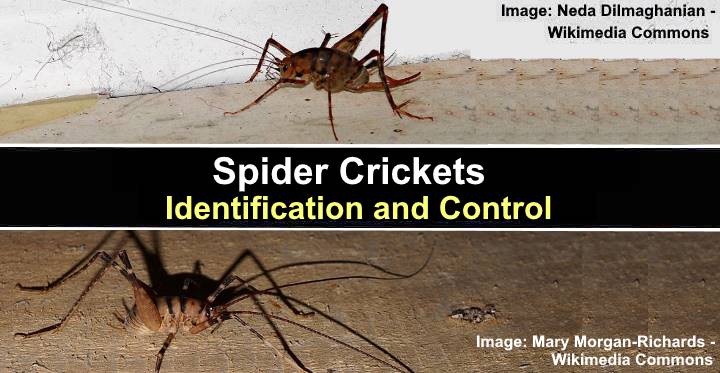
Spider crickets, also known as camel crickets or cave crickets, are medium-sized insects in the family Rhaphidophoridae. They are recognized for their distinct appearance, which includes a humpbacked body, six long legs, and long antennae. Spider crickets are typically brown or tan and are wingless.
Spider crickets are nocturnal creatures, active mainly at night, and prefer dark, damp environments. These insects do not have the ability to fly and are known for their jumping ability, thanks to their powerful hind legs.
Identifying spider crickets, cave crickets, or camel crickets is crucial for effective control measures. Although one or two of the jumping spider crickets are not an issue, they can invade homes in large numbers. Therefore, eliminating them from your home requires learning about where they live, their behavior, and their habits.
This article provides information on identifying and controlling spider crickets. Descriptions and pictures of these invasive pests will help you recognize them and disrupt their lifecycle. Additionally, you will get tips on spider cricket prevention and elimination to help you keep them out of your home for good.
What Are Spider Crickets (Rhaphidophoridae)?
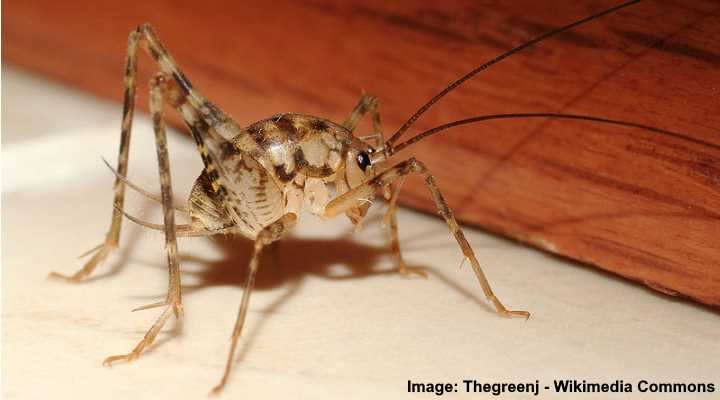
Spider crickets are medium-sized insects in the family Rhaphidophoridae. They earn their most common name due to their resemblance to spiders. They have six legs, long antennae, a humpbacked appearance, and thrive in dark environments.
Some of the alternative names for spider crickets include camelback crickets (due to their humpbacked shape), cave crickets (often found in caves), criders, sprickets (a portmanteau of spider crickets), cave weta (resembling weta insects found in New Zealand), or simply camel crickets.
Over 500 species of spider crickets exist. Despite being called crickets, they are not members of the field cricket superfamily (Grylloidea). Instead, they only have a passing resemblance to crickets. However, unlike crickets, spider crickets don’t make a noise. And unlike spiders (Arachnida), spider crickets have six legs and two antennae.
What Do Spider Crickets Look Like?

Spider crickets resemble a cross between a spindly, dark brown spider and a cricket. These wingless insects are brown, have two long, slender antennae, six legs, and humpbacked bodies. They measure approximately 2 inches (50 mm) in length and have drumstick-like hind legs that are about 4 inches (100 mm) long, which they use for jumping.

Spider crickets look menacing because of their spider-like appearance. They also congregate in large groups, making them appear threatening and ready to pounce. The good news is that spider crickets are not dangerous. However, they may jump at you if you startle them, or they feel threatened.
Do Spider Crickets Bite?
Spider crickets do not bite humans and are harmless nuisance pests. Although spider crickets bite organic matter, decaying plant material, or fungi with their mouthparts, they lack fangs, mandibles, and stingers associated with causing painful bites or stings.
However if a spider cricket lands on human skin, it may use its mouthparts to test the ground. This can be painful but will not damage the skin. Therefore, spider crickets are not dangerous and won’t cause physical harm.
What Do Spider Crickets Eat?
Spider crickets are omnivorous insects, and their diet includes a variety of organic matter, insects, and small arthropods. The six-legged jumping bugs typically scavenge in the wild for decaying plant material and fungi. In homes, where they infest damp basements, crawl spaces, and attics, they feed on fabric, paper, cardboard, and live houseplants.
Spider crickets are fond of dark, damp environments. Despite being annoying pests indoors, they play a beneficial role in ecosystems by helping to break down organic matter.
Do Spider Crickets Make Noise?
Spider crickets are silent insects that don’t make noises. Unlike field crickets, known for their chirping sounds, spider crickets don’t have wings to rub together to create the sounds associated with typical crickets. The fact that spider crickets don’t chirp is good—the constant noise of crickets won’t keep you up at night.
However, you won’t know you have these invasive silent insects in your house unless you see them.
Spider Crickets vs. Camel Crickets vs. Cave Crickets
Insects in the family Rhaphidophoridae are most commonly called spider crickets. The terms cave crickets and camel crickets refer to the same insects. Common names for the jumping cricket spiders usually refer to their shape (camel crickets or humpbacked crickets), habitat (cave crickets), or behavior (jumping weta).
Types of Spider Crickets
North America is home to over 150 species of spider crickets. Although each has its own characteristics, they are generally identified by their six long legs, two antennae, humpback, and superb jumping ability. Here are a few species of spider crickets you could find in your home.
Asian camel cricket (Diestrammena asynamora)
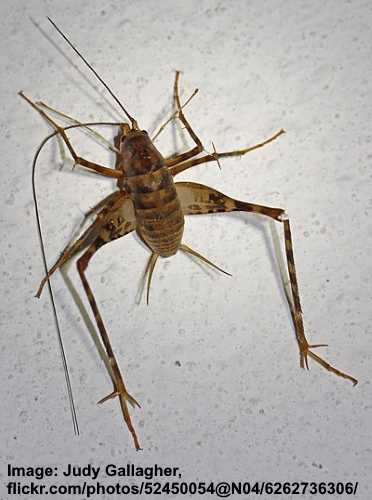
This large Asian spider cricket has a brown body, two long antennae, and huge hind legs. The insects measure 0.4” to 0.6” (11.3 – 14.6 mm) long. Also called greenhouse camel crickets, the non-native insect is one of North America’s most common spider crickets.
Common cave cricket (Hadenoecus subterraneus)
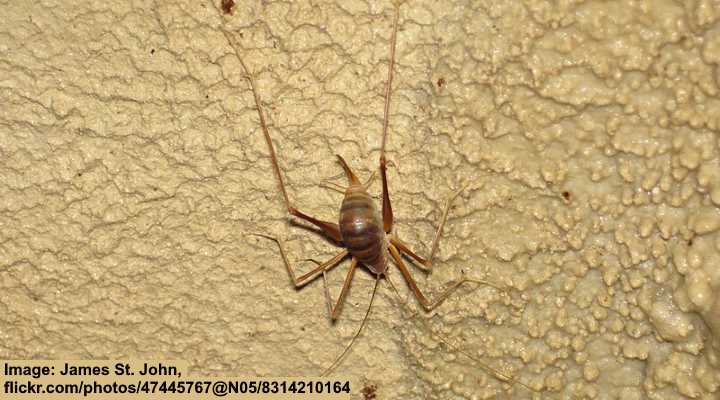
The common cave cricket is found in dark, moist environments. They have a characteristic humpbacked appearance, with long legs for jumping and two antennae. They grow 1” to 1.5” (25 – 38 mm) and range in color from brown to pale brown.
Kentucky cave cricket (Ceuthophilus stygius)
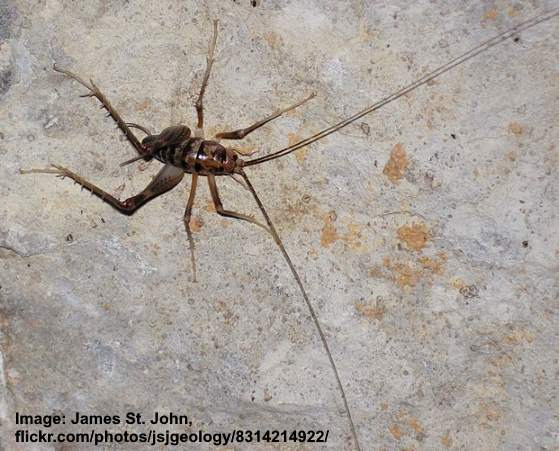
Native to the United States, the Kentucky cave cricket is generally found in dark, damp spaces like basements and cellars. Like other brown spider crickets, the dark-loving insect has a humpbacked appearance, long antennae, and long, slender legs.
Where Do Spider Crickets Live?
Spider crickets live in the wild throughout North America in dark, damp environments. You will find them under rocks, fallen leaves, and rotten logs. They invade homes and infest dark spaces like basements, sheds, crawl spaces, and cellars. However, they are nocturnal creatures, so you rarely see them during the day.
How to Identify Spider Cricket Damage
Spider crickets don’t bite, they are not venomous, and they don’t sting. However, they can cause damage to household items, especially if you have many of the long-legged brown insects in your home. For example, they can cause damage like common clothes moths by gnawing through linen, drapes, soft furnishings, clothing, and rugs.
Some people report that spider crickets have bitten their skin. However, these are rare occasions, and the insect’s mouthparts are not strong enough to break the skin.
Signs of Spider Cricket Activity
Signs of a spider cricket invasion can include various indicators. Apart from seeing the critters, you may notice a funky smell, powder like ground black pepper (feces), or small holes in drapes, carpets, or other household fabrics.
Sightings of spider crickets
The most obvious sign of a spider cricket invasion is finding them in your home. A group of long-legged brown spider-like critters with their huge antennae can be frightening. Or you may be in dark, damp areas like basements, crawl spaces, or the laundry room, and a brown spider cricket jumps at you.
Their distinctive body shape, long cricket-like legs, and antennae make them relatively easy to identify when spotted.
Spider cricket feces
You may notice spider cricket fecal matter in places where they gather. These droppings resemble ground black pepper. Of course, they could indicate other insect problems like pantry pests, cockroaches, termites, or bed bugs.
A foul odor
Spider crickets, particularly when present in significant numbers, can emit a musty or unpleasant odor. This odor may result from their fecal matter, discarded exoskeletons, or their scent. A foul smell can be a source of discomfort for homeowners.
Damage to fabrics and clothing
Spider crickets do not typically damage building structures like termites. However, they can cause costly damage to your possessions if they chew on fabrics or clothing. This behavior more likely occurs when they lack other food sources.
Rodents and vermin
Spider crickets can cause secondary infestations because they can attract other pests. Vermin, such as mice and rats, can invade your home looking for crickets to eat. Thus, increasing rodent activity alongside spider cricket sightings could indicate a broader pest issue that needs your attention.
Why Do I Have Spider Crickets in My House?
Spider crickets enter your house during hot, dry weather or after heavy rainfall. The pesky critters thrive in dark, damp environments. High humidity, basements, crawl spaces, and gaps around doors and windows are favorite habitats for the long-legged creature. Addressing moisture issues, sealing entry points, and using traps can help prevent infestations.
How to Prevent Spider Crickets From Getting Into Your Home
Focus on moisture control and seal gaps to prevent spider crickets from entering your home. Therefore, fixing leaks, ensuring proper ventilation, and addressing dampness issues are important for spider cricket control. Also, sealing gaps and cracks around windows, doors, and foundations is vital. It’s also a good idea to keep the perimeter around your home free from debris and shrubs.
Here are some easy ways to ensure spider crickets don’t get into your home:
Reduce humidity and moisture
To prevent spider crickets in your home, address moisture issues. Spider crickets are attracted to high-humidity environments. Therefore, it’s vital to ensure there are no leaking pipes in your home. Also, using a dehumidifier and keeping basements well-ventilated can help reduce indoor air moisture.
Lowering humidity levels in your home is one of the best ways of preventing spider crickets.
Seal entrances to your home
Stop spider crickets and other invasive insects from entering your home by blocking entry. Inspect your home for gaps and cracks around doors, windows, foundations, and utility openings. Caulk entry points to prevent spider crickets from squeezing through.
Additionally, pay particular attention to the foundation, like basement windows or doors where spider crickets easily get through cracks.
Declutter your home
Spider crickets love dark places. Therefore, reduce clutter as much as possible in and around your home to remove hiding spots for spider crickets. Areas to focus on include basements, storage areas, and laundry rooms. This makes the areas less attractive to the six-legged jumping pests.
Tidy your yard
Maintain your outdoor surroundings by trimming tall grass, shrubs, and overhanging branches near your home. Also, keep stacks of firewood and lumber piles away from your home. Remember, spider crickets hide in garden debris and clutter like under leaf litter, log piles, and rotting organic matter.
Use sticky boards to prevent spider crickets
Sticky boards or traps for household pests can help reduce the number of spider crickets. Place the boards in strategic places to capture wandering crickets. Ensure they are placed in dark, sheltered areas such as basements and crawl spaces to be most effective.
You can also put moldy bread beside the traps to attract the cricket spiders, so they hopefully get stuck on the sticky surface.
How to Get Rid of Spider Crickets
Spider crickets are common pests that can become a nuisance in homes. It is important to eliminate their food sources and create an inhospitable habitat to get rid of spider crickets. There are a few ways to eradicate spider crickets if they have become nuisance pests in your home.
Set homemade traps to eradicate spider crickets
You can make a simple DIY bug trap to kill spider crickets in basements and crawl spaces. All you need to do is fill a large container with water and add some liquid dish soap. The soapy water creates a slippery surface, preventing the nasty bugs from escaping. Additionally, the crickets will eventually drown in the liquid.
Use the vacuum cleaner to kill spider crickets
Vacuuming your floors in cellars, basements, and laundry rooms will eradicate spider crickets. Thankfully, spider crickets usually breed outside and enter homes through crevices and cracks. However, if females have laid eggs, vacuuming will remove any eggs and nymphs.
How Long Do Spider Crickets Live?
Spider crickets have a relatively short lifespan, typically living for one to two years. Their life cycle consists of eggs hatching in April or May and going through several nymphal stages before reaching adulthood. The nymphs mature over winter, and adult spider crickets live for another season before dying.
Spider Cricket Life Cycle
The life cycle of a spider cricket occurs in three stages—egg, nymph, and adulthood. Here is a brief description of a spider cricket’s life cycle.
Egg stage: Female spider crickets lay eggs in damp soil or similar environments in early spring. After several weeks, the eggs hatch into nymphs, typically in April or May. It’s rare for female spider crickets to lay eggs indoors because conditions must be ideal for hatching eggs.
Nymph stage: The young spider crickets emerge as nymphs and undergo seven or eight molts. During this stage, they resemble miniature adult crickets. The small insects eat the same foods as the adults—fabrics, fungi, other insects, cardboard, and decaying plant material.
Adult stage: After completing their nymphal stages, spider crickets reach adulthood. They continue to forage for food and may invade homes during dry weather as they are attracted to dampness. Therefore, they may spend the summer and fall in basements, laundry rooms, bathrooms, and cellars.
Reproduction: Adult females lay eggs in spring, restarting the life cycle.
The duration of each stage can vary, depending on factors such as temperature and humidity. Still, the entire life cycle typically spans one to two years.
Spider Cricket Behavior
Spider crickets are nocturnal insects, so they are mainly active during the night. While active, they search for food, which can include other small insects, plant material, paper, or fabric. During the day, the small brown insects shelter in dark, damp, and humid environments.
Their excellent jumping ability is one of the characteristics of spider cricket behavior. They are capable of jumping great distances thanks to their strong hind legs. Because they lack fangs, venom, or spinning abilities like true spiders, they use their legs to jump to escape predators.
Spider crickets navigate dark places using their super-long antennae. These allow them to find food, navigate their environment, and avoid obstacles.
Spider Cricket Habitat
Spider crickets typically inhabit dark, damp environments. Outdoors, the six-legged jumping insects inhabit caves, underground areas, under leaf litter, or hiding in decaying logs. They use their long antennae to sense their surroundings and locate prey. These habitats are typically cool and damp, providing the perfect conditions for spider crickets to thrive.
Indoors, you will likely find spider crickets in basements, crawl spaces, cellars, and damp environments. They also prefer homes with high humidity levels. Therefore, a spider cricket infestation could indicate overly moist conditions caused by dampness or leaking pipes.
Related articles:
- Types of Grasshoppers – Identification Guide
- How to Get Rid of Grasshoppers
- Grasshopper Look-Alikes: Katydids, Crickets – Identification Guide
